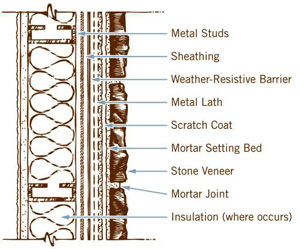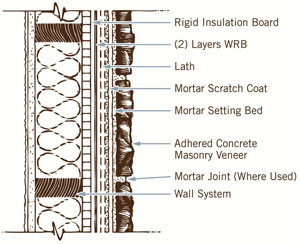Architectural Stone Veneers: Authentic and Appropriate Technology
 |
Photo courtesy of Eldorado Stone Typical wall section of stone veneer applied over metal studs. |
Metal
Metal stud construction is one of the most common construction types for commercial applications. Stone veneers applied over metal studs with no sheathing use corrosion-resistant self-tapping screws with a 7/16-in. head that provides a 3/8-in. minimum penetration beyond the metal surface. For installation over metal studs with sheathing, be sure to penetrate the inside metal surface by 3/8 in.
Stone veneer can also be applied over metal panels. Metal wall panels must provide a firm support and be a min. No. 18 gauge galvanized steel with a min. base-metal thickness of .0478 in. Attach the metal lath using self-tapping screws spaced 12 in. horizontally and 6 in. vertically. The scratch coat must be a minimum of 1/2 in. thick and be allowed to cure for at least 48 hours before installing veneer.
Wood
Commonly used in residential construction, apply stone veneer over wood sheathing or open stud framing by using a corrosion-resistant metal lath, a scratch coat and a mortar setting bed upon which the thin veneer is placed. The installer should use either a 2.5-lb. or a 3.4-lb. self-furred lath. Metal lath sheets should be overlapped at least 1 in. with the end pieces overlapping by a minimum of 2 in. Wrap lath a minimum of 16 in. around all corners. Stone veneer can also be applied over rigid insulation.
 |
Photo courtesy of Eldorado Stone |
Insulating Concrete Formwork (ICF)
One of the newest and highly energy-efficient building systems being used in a variety of large-scale multistoried commercial buildings is insulating concrete formwork or ICFs. This product is made from hollow blocks made of insulation or foam formwork into which concrete is poured. Cladding is adhered with fasteners and manufacturers will provide assistance as to the recommended installation systems for their individual product. If the support brackets cannot support the weight of the veneer system, the installer can attach the lath through the ICF panels directly to the concrete cores. This product is often used in cold climates and for large mixed-use complexes and hotels.
Installation Basics
In general, all veneers should be applied to structurally sound surfaces and meet all local building codes. A manufacturer will provide specific application requirements for their products. The design professional should verify that proper testing has been conducted of any product and the appropriate evaluation reports obtained as to claims of environmental benefits, such as the recycled content of materials, as well as the validity of material claims.
There is an art to stone masonry, and the craft of choosing the right piece of stone and the type of grout bond is the same with the laying of stone veneer. Mortar, the bonding material that is made of cement or lime, sand and water and is used to bind stone veneer into place as it hardens, is chosen by type for its hardness. Premixed type N or S mortar is used to adhere stone veneer in place. Type N mortar is typically selected for exterior above-grade walls. Mortar must meet or exceed ASTM C270. This ASTM standard measures the compressive strength of mortar tested under laboratory conditions. The standard sets criteria for air content, compressive strength, bonding, amount of Portland cement and lime, among other elements. Mortar is applied as a scratch coat over lath to provide a good bonding surface for the stone veneer. The scratch coat should be scored horizontally with a notched trowel to provide proper support for stone placement.
 |
Photo courtesy of Eldorado Stone Proper preparation and application of mortar to backside of stone veneer. |









